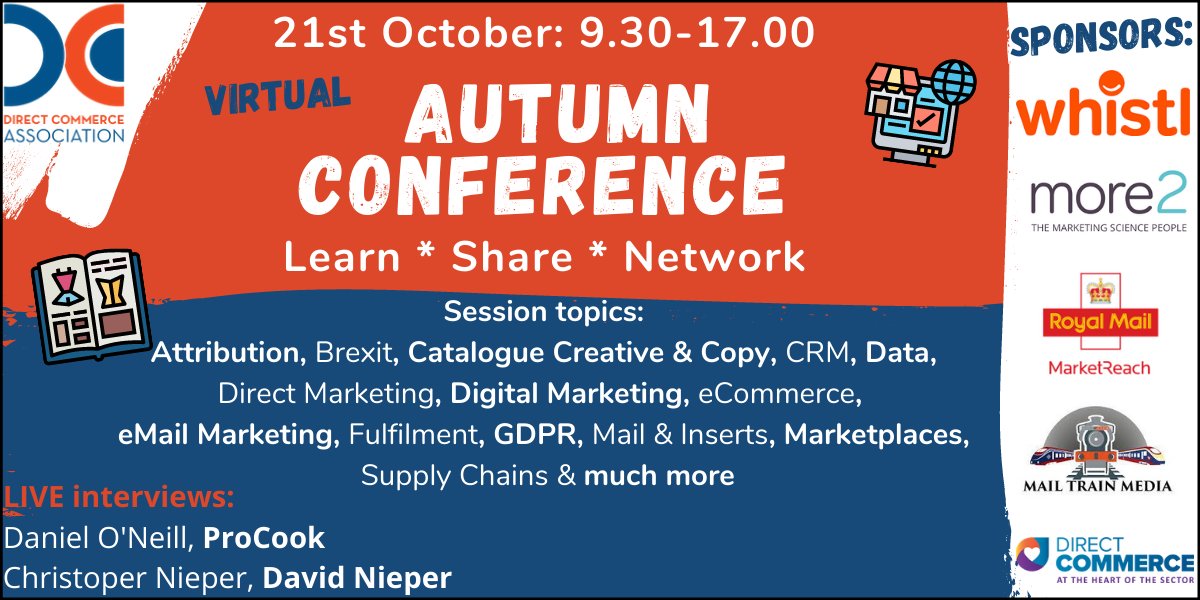
Whilst the DCA Autumn conference held on 21st October was once again virtual, this in no way impacted the quality and content of the sessions. Feedback from delegates has been very positive with many saying how valuable the sessions were, even if they could not attend in person.
We have all had to adapt to a new way of working and recurring themes throughout the conference revolved around supply chain issues, rising costs, and the need to remain agile. There was still a strong argument for the role that direct mail plays within the marketing mix. The importance of the customer journey and using the correct measurement metrics, holds as true today as it ever did.
DCA President Emeritus Nigel Swabey launched the conference looking at some of the challenges and opportunities experienced over the last year.
Shipping and supply chain frustrations
He and other speakers spoke of how shipping costs have escalated, sometimes more than tenfold, with document delays caused by Brexit leading to ships diverting to Europe. Add to that a doubling of energy prices and the fact that during shut down, there was a consumer shift to digital channels, it’s no wonder so many well-known retails have issued profit warnings.
Lorry delays mean stock has taken weeks to come through. Many retailers are also experiencing detention charges as there are not enough ships to take away the containers. This situation means that for heavier items, the cost of freight is prohibitive.
Keep it small and local
Nigel suggested retailers should focus on smaller items and pivot to UK and Europe for suppliers. “Everyone is in the same boat. Be selective and focus on smaller items”. Reassess your supply chains.
Indeed, the option of focusing on local sourcing and manufacturing in the UK was supported by other speakers, notably Chris Nieper, who sources and manufactures 100 per cent in the UK. Chris explained that “by manufacturing in the UK as much as possible, customs and duties are zero. Shipping costs especially from the far east have multiplied around 5 times, we have avoided this. Try and produce locally via a partnership or set up your own factory, which can all be done in stages”.
Paper price rises
Another issue has been the substantial increases in paper and print costs, with one supplier hiking theirs by some 36 per cent. Give that paper accounts (in the case of Scotts & Co) for 65 per cent of their costs of the package when it mails, this will have a major impact on our industry. Nigel urged that negotiations and sourcing new suppliers are an option, together with downgrading internal paper quality to around 40 gsm. Having a better-quality cover can disguise this downgrade.
Are catalogues dead?
Nigel spoke of recent press claims that “catalogues are dead” according to the Telegraph, which in turn gave rise to speculation ‘is this the end for catalogues?’
Perhaps so, for the larger tomes such as Next, Argos and IKEA. But the Scott’s portfolio doubled their catalogue volume in 2020 and are increasing that print runs again by around 30 per cent this year? Why? “Because it is profitable to do so”. Johnny Boden was cited as saying that catalogues are vital to support retail stores and websites. When Hawkins Bazaar stopped their catalogues, it impacted significantly on footfall to their shops. Catalogues also drive consumers to buy online.
Digital Vs Catalogues
Nigel explained that by using a small format recruitment mailing, they can “pull in 30k new customers in space of 6 weeks. This recruitment is achieved at a profit or at worst a very small loss. Conversely, digital will cost around £10 a customer to acquire. Direct mail is scalable – digital is not. Costs are soaring in digital. Direct mail offers value for money, catalogues are much more effective and much cheaper”.
“Targeting is key, don’t be imprecise- use agile more versatile vibrant and dynamic catalogues”.
Sophie Grender, from the Royal Mail, proved that we can still make a physical impact in a digital world, achieving engagement rates of around 94 per cent with mail. She talked about the rise of ‘phygital’ where 9 in 10 Generation Z (Zoomers born between 1997 and 2012), prefer brand experiences that combine physical and digital. They take notice, trust mail and it drives people to search for more information after receiving mail.
Huge leaps in technology enable us to drive offline to online. That could be via the use of QR codes, Apps to facilitate customers to see products in-situ, scanning products in a magazine and being taken to the appropriate online page.
Lifetime value
Nigel stressed the importance of the average order value. “Digital advertising is low cost- but what are the ROAS figs you are achieving. Online customers spend less than half than those recruited by DM- order less often and lower order value – which translates to less than the half lifetime value”. This was backed up by delegate speaker Paul Pates of Mr. Fothergills who noted that “catalogue customers are the most loyal, spend more and stay longer”.
Storytelling and personalisation
Today’s catalogues need to be sleeker, more sophisticated and sell a lifestyle, by telling a story. Matt Fey explained, “We need to create greater emotional engagement to disrupt, delight and drive them to action”. People do still like browsing through a catalogue for inspiration and respite from screen browsing. Personalised direct mail is read, an average of 4.5 times. In the digital age, personalisation is now more difficult. Many prospects are now anonymous so we need to come up with generic stories that still resonate with our customers. Offer a variety of digital advert creatives (3/5 per ad set) for example Facebook can serve Dynamic ads for broad audiences. Also, look at channels such as Pinterest and TikTok.
Attribution is key
Nigel urged retailers to look at the true costs of each channel and consider the aspect of attribution very carefully, such as ‘source unknown- bucket channels’. Many customers are driven to order online via a catalogue, and 33 per cent of direct mail leads to commercial action, so mailing lists need to be cross referenced against online orders. Remember there are many touchpoints during the customers buying journey- are you over counting? Build an attribution model to fractionally allocate sales to each channel for a deeper insight.
Sustainability
Nigel also urged mailers to consider using MailMark and stop using Poly. Mailers need to switch to using envelopes and paper wraps, thereby affording you access to the current sustainable mail rates (which will soon be withdrawn so make the most of them while they last!). He also urged mailers to “search out new packets of data to mail and find new recruitment opportunities”.
Rob Bielby looked at the soft opt-in as a means to grow the marketing file. If you are trading online and an email is collected during the course of a sale or a negotiation, that email address can be added into your marketing file even if it was part of an abandoned basket (not just via a cookie) or if captured as a guest checkout.
Rob also reminded delegates that customer data from failed businesses can be bought and used without qualification if acquired correctly and used for the same purpose. But as Nicola Fox emphasised, make it clear why customers can benefit from sharing their personal info with you, such as offering a better service.
Investing in homegrown talent
As mentioned earlier, Chris Nieper OBE- CEO David Nieper, shared the value of sourcing locally and developing homegrown talent. He cautioned that customer satisfaction and prompt delivery is still vital, “you are only as good as your last delivery- disappoint your customers and you risk losing them. Back-end service levels are the make or break for repeat sales. Make it a good experience so customers come back.
Chris also spoke about the importance of staff retention and developing strong links with local schools and colleges. “Don’t just think skills- recruit for attitude and train for skills.
Old learnings still apply
Chris Simpson from More2 discussed how we all face growing challenges on how we target, measure, and deliver relevance. The old school classic approach is still relevant today, looking at targeting, interaction, control and continuity.
Points echoed by Nicola Fox “It is important to give your audience what they want to hear not just what you want to say”.
Chloe Thomas in her eCommerce master Class urged marketers to look at the offer and then look at the right segments and channels and timing and “structure your teams around the customer and not the channel”.
Summary
Whilst paper costs are soaring and supply chains are challenging, there are techniques you can employ to mitigate problems. We all just need to adapt, “winners embrace change” but recognise those old school basics still apply, even in a digital world. We need to be omnichannel and allow customers the choice of how they interact with brands. Segmentation, profiling, and personalisation are still important. The role of attribution is key, and the use of smaller, mail order catalogues that are well-targeted and tell a story, should still be an important part of any marketing mix.
Members can delve deeper and view the sessions on the DCA’s YouTube channel
by Claire Hart, Associate Contributor, Direct Commerce Magazine





Share